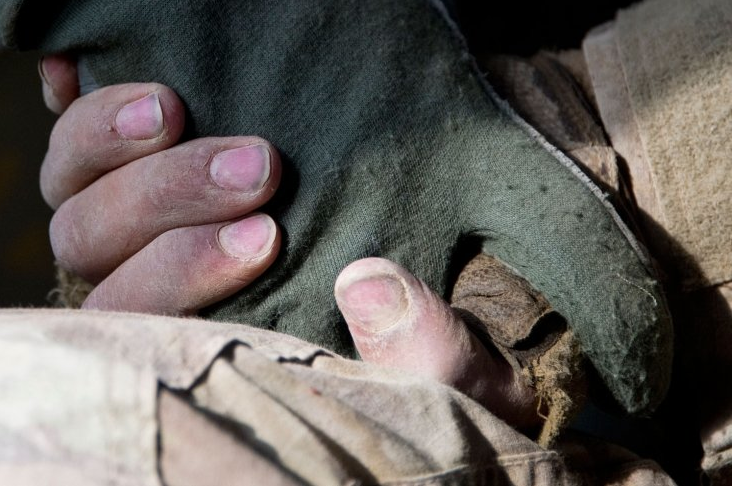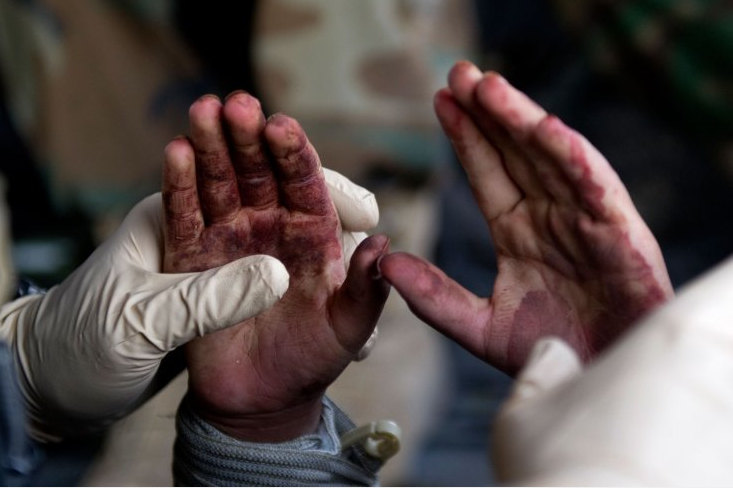We have discussed the costs of war on many occasions. And as we have noted, such costs cannot easily be calculated as they are variously and incommensurately measured in dollars and cents, lives interrupted and lost, the disruption of social and civic norms, and so on. Photography, with its capacity to enact a realist aesthetic—the so-called “window on the world”—offers a powerful optic for how to see these costs in bodily terms, and occasionally in ways that challenge our normative assumptions about where the bottom line might reside. The photograph above is a case in point.
The liberal assumption is that we identify individuals by their faces—or maybe by their clothing. But here the camera focuses on the hand to the exclusion of any other bodily identifications. In fact, what we see are two hands grasping one another. Gender is effaced, but so too nationality, or for that matter, any obvious political, or ideological differences. But more to the point, is that there do not appear to be any clear signs of pain and injury—but somehow we know that both are present. Ultimately, it is the caption that clues us to the particularities of the scene as it indicates that one hand belongs to U.S. soldier who how has suffered the effects of an Improvised Explosive Device (IED) in Afghanistan’s Kandahar Province, while the other belongs to a U.S. flight medic giving comfort and aid. But in a larger sense it is the grasping embrace itself—tight but also tender—that makes the point; perhaps it is something on the order of a universal sign of support and connection, of contact at a moment of crisis or distress, that underscores the fundamental humanity that is at stake. The hands touch one another and in the process they touch us.
The hand, of course, with its opposable thumb, is uniquely human. As such, photographs that feature only the hand become synecdoches for the human experience and by extension models of human polity. Indeed, the gestural iconography in which hands are employed to communicate the sentiments of public life is far ranging and complex, but at its heart is a collective rather than idiosyncratic or personal experience. The reaction of one person to an event might be a human-interest story, and the deeply personal experiences of private life can achieve profound resonance in literature or other arts, but photojournalism typically depicts experiences that are created by common conditions. A photograph that focuses solely on the hand can intensify and amplify those conditions. What matters in the photograph above, then, is that care is being enacted at a moment of distress. It matters little that we know the individual identity of the people involved. The photograph communicates the experience of caring and connection, and so offers the realm of collective experience as a model for human engagement.
But there is more, for when such a photograph is placed in comparison with other “similar” photographs, as in a slide show on the Casualties of War, the “gesture” operates in multiple registers that serve not only as models of behavior, but also invite social and political judgments. So then, we find this photograph:
Once again all measures of identity are effaced and one would not know that this was a young Afghan girl suffering from a shrapnel wound but for the caption. Nor in one sense, at least, does it really matter, for now the context has changed, and not just because the gesture within the image itself seems a bit more clinical, but because together the two photographs (and others in the same slide show) serve as a gesture to the real cost of war—this war or any war—as fundamentally human. When faces and uniforms are foregrounded it is hard to lose sight of the fundamental humanity at stake; when focusing on hands alone it is clear that the photograph itself is not simply a window on the world, but indeed is a mechanism for gesturing to aspects of the world that are otherwise difficult to see.
Photo Credit: Johannes Eisele, AFP/Getty Images


Discussion